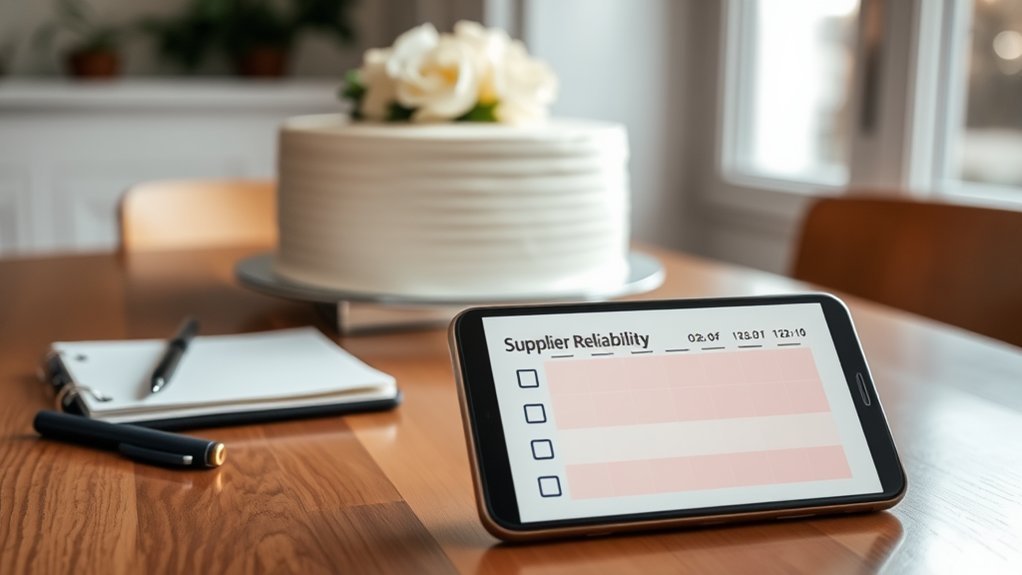How to Choose the Right Cake Supplier for Your Business
Choosing the right cake supplier for your business is crucial. Start by identifying your target market and assessing local demand. Look for suppliers that demonstrate financial stability and consistently deliver quality products that match your brand values. Building strong relationships with your suppliers is vital, so ensure there’s clear communication and shared objectives. Additionally, consider how versatile their offerings are and their ability to adapt to seasonal trends, like Christmas cakes or summer desserts. By focusing on these key areas, you’ll establish a solid foundation for long-term success.
Key Takeaways
- Check potential suppliers for reliability and delivery consistency by looking at performance indicators and feedback from previous clients.
- Assess the quality of their ingredients and production standards to ensure they meet your business needs.
- Set up clear communication channels to build trust and quickly resolve any issues with suppliers.
- Understand the suppliers’ pricing structures to ensure they fit within your budget and help achieve your profit targets.
- Foster strong relationships with suppliers by establishing common goals and regularly reviewing their performance to improve collaboration.
Identifying Your Target Market

How well do you know your target market? To effectively serve your customers, it’s crucial to conduct a thorough demographic analysis. Focus on factors like age, location, income, occupation, and education. Understanding these elements allows you to tailor your products and pricing. Additionally, conducting market research**** is essential to identify local demand and preferences, which can further enhance your product offerings.
Additionally, psychographic profiling is vital. Identifying your customers’ values, interests, lifestyle, and behaviours will help you forge meaningful connections. By creating detailed buyer personas, you can segment your market based on specific needs, improving engagement with each group.
Don’t overlook market research for insights into local preferences and emerging trends. This strategic approach ensures you know what differentiates your business, leading to a more focused and effective marketing strategy. Furthermore, defining your target audience is essential for aligning your offerings with customer expectations.
Assessing Local Demand for Cakes

What factors influence local demand for cakes in your area? It’s important to grasp consumer preferences and market trends. Begin by examining demographic influences and historical sales figures to identify patterns. There’s a notable shift towards healthier, bespoke cakes, reflecting changing tastes. Additionally, the growing trend towards health and wellness influences choices, making organic options increasingly popular among consumers. Seasonal events often boost demand, so consider offering limited-time products tailored to these occasions. Additionally, understanding key cost factors like ingredients can help you better align your offerings with local preferences.
| Market Segment | Consumer Preference | Seasonal Impact |
|---|---|---|
| Sponge Cakes | Gluten-Free Options | Holiday Celebrations |
| Birthday Cakes | Personalised Designs | Weddings |
| Online Orders | Innovative Flavours | Seasonal Promotions |
| In-store Bakeries | Fresh, High-Quality Goods | Peak Sales Periods |
Understanding Market Positioning

To successfully position your cake business, begin by identifying your target market and understanding their unique needs and preferences. A competitive analysis will highlight what differentiates you in a saturated market. Additionally, forming strategic partnerships can enhance your product offerings. These actions are crucial for establishing a strong market presence and fostering customer loyalty. Understanding effective customer service is also essential to retain clients and build lasting relationships. Prioritizing high-quality ingredients ensures that your products meet customer expectations and stand out in the competitive landscape.
Target Market Identification
Identifying your target market is crucial for successfully positioning your cake business in the competitive UK market.
Begin by analysing demographic factors such as location, age, and income to identify potential customers. Then, delve into psychographics—consider their values, lifestyles, and attitudes—to shape your marketing strategies effectively.
Segment your market based on these traits to create personalised campaigns that truly resonate.
Develop detailed buyer personas to represent your ideal customers, guiding your approach.
Keep an eye on market trends, such as the growing demand for gluten-free and vegan options.
This comprehensive understanding not only boosts customer engagement but also ensures your offerings meet their preferences, ultimately setting your cake business up for success in a crowded marketplace.
Competitive Advantage Analysis
With a solid understanding of your target market, it’s time to evaluate your competitive advantage in the cake industry. Concentrate on brand differentiation strategies that appeal to consumers seeking premium and artisanal products.
Customisation options can set you apart, catering to various dietary requirements. Stay informed about trends in sustainable sourcing; investing in eco-friendly packaging can attract environmentally aware customers.
Employ tools like VRIO analysis to examine your unique selling points, such as high-quality ingredients and streamlined supply chains. By analysing competitors’ strengths and incorporating customer feedback, you can sharpen your market positioning.
Highlighting prompt delivery and a varied menu will enhance your appeal, ensuring you meet the changing demands of today’s cake market.
Strategic Partnership Development
Navigating the complexities of market positioning can be challenging, but forming strategic partnerships can significantly boost your cake business’s competitive advantage.
Start by conducting thorough market research to identify potential partners whose strengths align with your offerings, ensuring brand consistency.
For instance, if you specialise in gluten-free cakes, collaborating with a local health food shop could be beneficial.
Analyse the customer bases of potential partners to ensure they match your target audience, and observe your competitors’ collaborations to identify any market gaps.
It’s essential to clearly define partnership goals that highlight mutual benefits, enabling you to leverage each other’s strengths for greater efficiency and innovation.
Legal agreements should be straightforward, clarifying roles and expectations to ensure smooth operations.
Ultimately, strategic partnerships can help you expand your market reach, enhance your credibility, and reduce costs, providing essential advantages for long-term success in the bakery sector.
Evaluating Financial Considerations

When assessing financial considerations for a cake supplier, it’s vital to examine their financial stability and pricing strategies. Start by looking into their financial history and creditworthiness to determine their reliability. Request bank references and review audited statements for clarity. Assess their cash flow to ensure they can consistently meet orders.
Next, understand their pricing models, including any discounts or tiers available. Compare their prices with those of competitors to ensure they’re reasonable, and check for price fluctuations. Don’t hesitate to negotiate bulk order discounts.
Lastly, make sure all costs are clearly outlined to avoid unexpected fees. By focusing on these key points, you can establish a solid partnership that supports your business’s growth and quality of service.
Analyzing Cost-Effectiveness

When analysing cost-effectiveness, it’s essential to adopt competitive pricing strategies that fit your business model.
Consider the long-term costs of your supplier choices; initial savings might affect your overall profitability. For example, choosing a cheaper supplier could lead to higher maintenance costs down the line.
Competitive Pricing Strategies
Competitive pricing strategies are crucial for keeping your cake business attractive to customers while ensuring profitability.
Begin by examining the pricing of local competitors to understand your position in the market. Consider using dynamic pricing, adjusting your rates based on demand changes, so you can maximise sales opportunities.
Bundling products can also encourage larger purchases; for instance, offering a discount on a dozen cupcakes when bought together can provide value to customers and increase your revenue.
Regular market research is key to staying updated on current price trends, allowing you to adjust your prices as needed.
Don’t overlook the power of targeted discounts and limited-time promotions; these can create a sense of urgency and foster customer loyalty.
Long-Term Cost Analysis
To run a successful cake business, understanding long-term cost analysis is crucial for assessing cost-effectiveness. Start by meticulously tracking all ingredient and labour costs, and include overhead expenses to establish your base price.
Employ effective pricing models like cost-plus and value-based pricing to ensure your prices are competitive yet sustainable. Regularly forecast costs to anticipate market changes and avoid underpricing, which can threaten your long-term profits.
Keeping detailed financial records enables you to adapt your strategies based on customer demand and ingredient price fluctuations. By prioritising long-term sustainability and operational efficiency, you can boost your business’s profitability and establish yourself as a trusted provider of quality cakes, ultimately benefiting your customers.
Ensuring Quality Consistency

Ensuring quality consistency is crucial for any cake supplier looking to meet customer expectations and cultivate a loyal clientele. Here are some key strategies to consider:
- Implement Quality Metrics: Regularly evaluate your products using specific metrics to ensure that taste and texture remain uniform.
- Conduct Consistency Checks: Carry out routine checks during production to uphold high standards, covering everything from ingredient sourcing to hygiene practices.
- Maintain Open Communication: Build transparent relationships with your suppliers to quickly address any quality issues that arise.
Assessing Supplier Reliability and Delivery

When assessing supplier reliability, it’s crucial to ensure they deliver on time and offer flexibility with orders.
Set clear metrics to evaluate how consistently suppliers meet deadlines and adjust to your changing requirements.
For example, if you have a seasonal spike in demand, a reliable supplier should be able to scale up their deliveries accordingly.
Timely Delivery Assurance
Timely delivery assurance is vital for staying competitive in the cake supply industry, as it directly impacts operational efficiency and customer satisfaction.
Here are some strategies to ensure reliability:
- Supplier Audits: Regularly assess suppliers to ensure they meet their delivery commitments.
- Performance Indicators: Establish clear benchmarks for delivery frequency, speed, and reliability to monitor supplier performance.
- Effective Communication: Maintain open lines of communication to swiftly resolve any delivery issues that may arise.
Order Flexibility Options
How can you ensure your cake supplier meets your changing business needs? Start by checking their custom order options. A supplier that offers a range of cake flavours and designs can cater to various customer tastes.
It’s also vital they provide dietary options, like vegan or gluten-free cakes, to widen your market.
Look into their delivery flexibility, including different timeframes and areas they cover. A dependable supplier should maintain consistent product quality and have clear communication channels to manage any changes or emergencies effectively.
Finally, consider their packaging options and payment terms to fit your business model. By choosing a supplier with these qualities, you can better meet your customers’ needs while ensuring operational efficiency.
Exploring Supplier Capabilities

When evaluating potential cake suppliers, it’s crucial to assess their capabilities in key areas that affect your business.
Look for suppliers who excel in:
- Product Variety: Ensure they provide a wide selection of baking ingredients, including both specialty items and quality staples, to meet your customers’ demands.
- Quality Standards: Check their quality assurance processes to confirm that all ingredients comply with local health regulations and maintain consistent quality.
- Delivery Efficiency: Verify that they’ve effective logistics in place for timely deliveries, accommodating your order size and frequency.
Building Strong Supplier Relationships

Building strong relationships with your suppliers is vital for long-term success in the cake supply chain. Trust is key, and fostering clear communication is essential. Regular updates and straightforward exchanges help ensure everyone is on the same page and reduces the chance of misunderstandings.
Encourage open discussions about market trends and challenges, which can lead to innovative solutions. Setting clear performance standards allows you to monitor supplier efficiency, ensuring accountability and commitment.
When issues arise, work together to find solutions, which strengthens trust and stability. By aligning your goals with those of your suppliers, you both share a vested interest in mutual success.
A solid partnership not only streamlines operations but also builds a more resilient supply chain, benefiting everyone involved.
Importance of Product Versatility

A strong relationship with your suppliers is essential for recognising the importance of product versatility in your cake business.
Embracing versatility helps you cater to a wide range of customer preferences and sets you apart in a competitive market.
Here are some key considerations:
- Flavour Trends: Offer a blend of classic and unique flavours, along with seasonal specials, to keep your menu exciting and relevant.
- Dietary Options: Include gluten-free, vegan, and allergen-friendly cakes to expand your customer base and ensure everyone can enjoy your products.
- Size and Packaging: Provide various sizes and custom packaging options to enhance your brand and accommodate different events, from birthdays to weddings.
Leveraging Digital Platforms for Ordering

How can utilising digital platforms transform your cake ordering process? By integrating eCommerce, you can streamline operations, cut costs, and improve customer satisfaction. Customers will find it easy to browse and personalise their cake orders online, leading to a better overall experience.
| Feature | Benefits | Tools |
|---|---|---|
| eCommerce Integration | Streamlined operations, lower costs | OrderEm, Vev |
| Customer Customisation | Tailored orders, enhanced experience | Custom Order Forms |
| 24/7 Availability | Convenience, boosted sales | Online Ordering Systems |
| Data Organisation | Improved marketing strategies | AI Tools |
Adopting these digital solutions not only makes your ordering process more efficient but also allows customers to make personalised choices, encouraging loyalty and repeat business.
Strategies for Long-Term Partnership Success

To build successful long-term partnerships with cake suppliers, it’s essential to adopt a strategic approach centred on trust, communication, and shared growth.
Here are some key strategies to ensure your partnership endures:
- Regular Communication: Keep open lines for updates and feedback. This shows your commitment and helps both parties stay aligned.
- Transparency and Timely Payments: Be clear in your dealings and ensure payments are made promptly. This builds trust and reliability.
- Supplier Evaluation: Get to know their operational capabilities and product range. This understanding allows you to set aligned goals effectively.
Frequently Asked Questions
What Are the Best Cake Types for Different Occasions?
For different occasions, think about wedding cakes for their elegance and personal touches, while birthday cakes evoke joy and nostalgia. Each cake should align with the event’s theme to ensure a memorable experience for your guests. For example, a classic tiered wedding cake can be beautifully adorned with fresh flowers, whereas a fun, colourful birthday cake can feature the guest of honour’s favourite characters.
How Do I Handle Cake Storage After Delivery?
To keep your cake fresh after delivery, follow these simple refrigeration tips. Store your cake in a cool, dry place to maintain its texture and flavour. For example, if you have a cream-filled cake, it’s best to pop it in the fridge. Always check your cakes regularly to ensure they’re still fresh, so your guests can enjoy them at their best.
Can I Customize Cakes for Specific Events?
Yes, you can customise cakes for specific events. Consider options like personalised designs, flavours, and decorations to ensure your cake matches the theme and appeals to your guests. For instance, a floral design for a wedding or a fun character cake for a child’s birthday can make a big impact.
What Should I Do if There’s a Quality Issue?
If you come across a quality issue, it’s essential to remember the importance of verifying your suppliers rather than taking them at their word. Make quality assurance a priority by maintaining open communication with suppliers, clearly outlining your expectations, and promptly addressing any concerns. This approach will help you uphold your commitment to quality and customer satisfaction. For example, if a batch of products doesn’t meet your standards, reach out to the supplier immediately to discuss the issue and find a solution.
How Can I Promote Cakes to My Customers Effectively?
To promote your cakes effectively, utilise social media to share eye-catching images and engage your customers with interactive posts. Respond to comments quickly, run polls, and give sneak peeks of your baking process. These strategies help build relationships and enhance customer loyalty.
Conclusion
Choosing the right cake supplier is crucial for your business’s success. Start by understanding your target market and assessing local demand to make informed decisions. For instance, a café that teamed up with a versatile supplier experienced a 30% boost in customer orders by introducing seasonal flavours. This highlights the importance of aligning your product range with what customers want. Building strong relationships with suppliers and using digital platforms can also help your business adapt and thrive in a competitive market.


